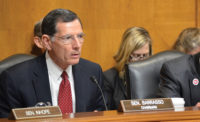Water Infrastructure
Key Senators Unveil $24.6B Water Resources Bill
Bipartisan bill heads for May 4 committee vote

Committee Chairman Carper released the draft bill text April 29, with plans for a May 4 vote.
Photo Courtesy Senate Environment and Public Works Committee
Senate Environment and Public Works Committee leaders rolled out a bipartisan water resources bill on April 29 that would authorize about $24.6 billion in federal funds for 21 Army Corps of Engineers flood and hurricane protection, harbor dredging and other projects around the country.
In releasing the text of the draft bill, Committee Chairman Tom Carper (D-Del.) and Sen. Shelley Moore Capito (W.Va.), the panel’s top Republican, said they plan to hold a committee vote on the measure on May 4.
[View one-page bill summary here, detailed section-by-section document here and text of draft bill here. ]
By far the biggest individual project allocation in the proposed legislation is $19.2 billion for a coastal Texas restoration plan. The project’s estimated total cost is $30.9 billion.
The lawmakers are aiming to have Congress clear a new Water Resources Development Act, or WRDA, this year. That would continue the practice in recent years of passing a WRDA on a biennial schedule.
As with past WRDAs, project authorizations are the centerpieces of the new proposal.
Besides the coastal Texas project, another large allotment in the bill is $1.5 billion for hurricane and flood protection in the Florida Keys.
More Projects Expected to Be Added
If the past is any guide, the size of the 2022 WRDA could well grow if Lt. Gen. Scott Spellmon, the Army’s Chief of Engineers and Corps Commanding General, approves “chief’s reports” recommending additional projects in coming months.
Mike Strachn, a senior adviser at water resources consulting firm Dawson & Associates, says that, historically, as WRDA bills make their way in Congress, pressure is put on the Corps to focus on projects at the feasibility study stage that might not be ready for chief's reports until the following year. "And they put the accelerator on them to get those things finished, so they become eligible for inclusion in WRDA."
One cautionary note is that, as in the past, project authorizations in WRDA bill are subject to annual appropriations.
Carper said in a statement, “This legislation builds on our historic infrastructure investments in the Bipartisan Infrastructure Law [formally the Infrastructure Investment and Jobs Act] and the past WRDA bills, authorizing projects in all 50 states.”
He added, “Importantly, our bill modernizes the way we approach water resources projects nationwide by ensuring climate and equity are priorities, not afterthoughts in the Corps’ work.”
Policy Provisions
John Doyle, special counsel with law and lobbying firm Jones Walker LLP, tells ENR that one important policy provision in the proposed WRDA is a change in the funding shares for river lock and dam projects. At present, 65% of a project’s cost is covered by general federal revenue and 35% from the Inland Waterways Trust Fund.
The Senate draft would increase the general fund’s share to 75% and trim the trust fund’s share to 25%. It also would make those percentages permanent.
Doyle, a former senior Army civil works official, says industry favors the increased general-fund share because the inland waterway projects "produce national benefits across the whole reach of our economy."
Strachn says of the Senate committee leaders' proposal, "I would not consider this a policy-heavy draft WRDA."
But Strachn, formerly a Corps civil works official, does highlight several policy changes in the bill. One provision affects projects that undergo emergency repairs in the wake of storms or other natural disasters.
The new bill would encourage the Corps to go beyond just restoring the structure to its previous status and bring it up to current hydrologic conditions that reflect the impact of climate change.
The House Committee on Transportation and Infrastructure has not yet introduced its version of a 2022 WRDA.
But Doyle says there is a lot of WRDA activity in that chamber. "It's just all behind the scenes," he says.
Story updated on 5/2/2022 with comments from Dawson & Associates.




